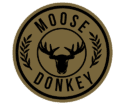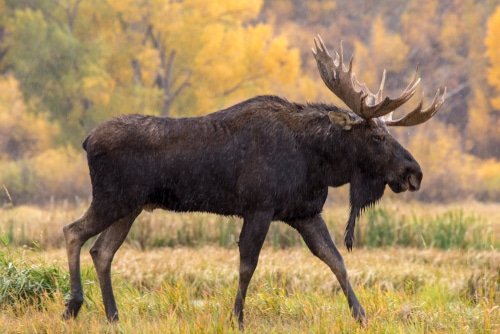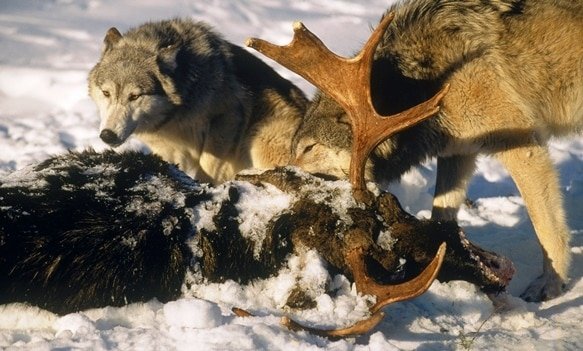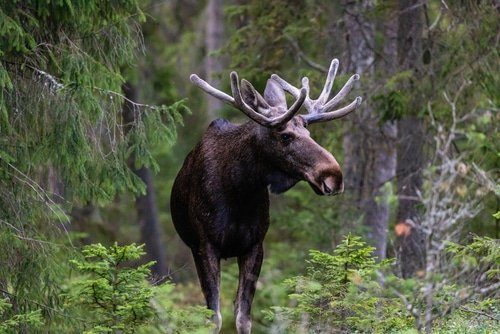Welcome, fellow outdoor enthusiasts, to the thrilling world of moose hunting! As you embark on this grand adventure, be prepared to dive into the heart of nature and discover the majesty these magnificent creatures possess. We’re here to give you some moose hunting tips to make your journey successful.
Moose hunting has captivated seasoned hunters and novices alike for centuries, drawing them into the vast wilderness in pursuit of a mighty trophy bull or a delicious source of sustenance. Moose hunting is not merely a pastime; it is an art that requires dedication, perseverance, and a profound respect for nature.
The challenge lies in locating these elusive creatures, understanding their behavior, and adapting hunting techniques accordingly. Proper preparation and knowledge are vital ingredients for achieving success in this endeavor.
The Importance of Preparedness: Unlocking Your Potential as a Successful Hunter
Moose hunting demands meticulous planning and thorough preparation. A well-prepared hunter possesses an inherent advantage when navigating the wild expanses inhabited by these majestic giants. By immersing yourself in this beginner’s guide to moose hunting, you will equip yourself with invaluable insights that can significantly increase your chances of triumph.
Understanding moose behavior and habitat is paramount to embark on this thrilling journey properly. These marvelous creatures have distinct patterns influenced by mating season and territoriality.
Moreover, comprehending their preferred habitats—dense marshes or sprawling forests—will empower you to make strategic decisions while scouting for your elusive target. As we delve deeper into this article, we will unravel essential gear requirements tailored specifically for moose hunting.
We’ll share valuable tips on planning your hunt effectively by researching regulations and selecting optimal locations based on population density and accessibility. Intrigued?
Excited? You should be!
So let us proceed further into this enlightening exploration of moose hunting, where we will unlock the secrets to tracking moose in the wilderness, mastering calling techniques, ensuring ethical shot placement, and safely field dressing your prized harvest. Adventure awaits around every corner!
Understanding Moose Behavior and Habitat
Insight into moose behavior, including mating season and territoriality
When understanding moose behavior, it’s essential to delve into their fascinating mating habits and territorial nature. The moose’s mating season, known as the rut, typically occurs in the fall. During this time, bulls become particularly aggressive as they compete for the attention of females.
They communicate their dominance through vocalizations like grunting or thrashing their antlers against trees. It’s a spectacle, but hunters must exercise caution during this period.
Moose are highly territorial creatures, especially during the rut. Bulls mark their territory by creating rubs on trees using their antlers or leaving droppings in specific locations.
These signs serve as warnings to other bulls and also signal females that they are suitable mates. Understanding these behaviors allows hunters to locate potential hunting grounds more effectively.
Detailed description of preferred moose habitats, such as marshes and forests
Understanding moose habitat preferences is key to increasing your chances of a successful hunt. Marshes and wetlands are prime areas for spotting these majestic creatures.
Moose are excellent swimmers and enjoy spending time in aquatic environments where they can feed on aquatic plants like water lilies or wade through shallow waters. Forests with dense cover provide significant advantages for feeding and protection from predators.
Moose primarily feed on leaves, twigs, bark, and aquatic plants near lakes or streams in forested areas. Knowing where moose prefer to graze helps narrow down potential hunting spots considerably.
Different hunting techniques may be required depending on whether you’re targeting bulls during the rut or simply looking for a general beginner’s guide to moose hunting in various seasons. By familiarizing themselves with moose behavior patterns unique to each season and identifying their preferred habitats, hunters can greatly increase their chances of a successful and fulfilling moose hunting experience.
Essential Gear for Moose Hunting
Comprehensive list of necessary equipment, including firearms, ammunition, and optics
When it comes to moose hunting, having the right gear can make all the difference. Let’s start with firearms.
A rifle chambered in .30-06 Springfield or .300 Winchester Magnum is highly recommended for taking down these majestic animals. These calibers offer enough power and accuracy for a clean kill.
Make sure to practice your marksmanship skills before heading out into the field. In addition to a reliable firearm, you’ll need an ample supply of ammunition.
Opt for premium bullets designed for big game hunting, like Nosler Partition or Barnes TTSX. These bullets provide deep penetration and controlled expansion to ensure an ethical harvest.
Regarding optics, a quality scope is essential for spotting and accurately targeting moose at various distances. Look for scopes with variable magnification (around 3-9x) and a large objective lens diameter (around 40-50mm) to gather enough light in low-light conditions.
Discussion on appropriate clothing and footwear to ensure comfort and safety in the wilderness
Moose hunting often occurs in rugged terrains and unpredictable weather conditions, so choosing the right clothing and footwear is crucial for comfort and safety. Layering is key when dressing for moose hunting as it allows you to adjust your clothing according to changing temperatures throughout the day.
Start with a moisture-wicking base layer that helps regulate body temperature by keeping sweat away from your skin. Over that, wear insulating layers like fleece or wool to trap heat efficiently.
As for outerwear, opt for waterproof jackets and pants made from breathable materials such as GORE-TEX or similar fabrics that protect you from rain or snow while allowing moisture vapor to escape. Don’t forget gloves designed specifically for hunting, as they provide both warmth and dexterity.
Regarding footwear, invest in a sturdy pair of hunting boots with good ankle support and a reliable tread pattern for traction on various terrains. Look for insulated and waterproof boots to keep your feet warm and dry during long hours in the field.
Remember, comfort is essential during hunts that require patience and stealth. By choosing the right gear, you’ll be well-equipped to tackle any challenges that come your way while enjoying a successful moose hunt.
Planning the Hunt
Researching hunting regulations and obtaining necessary licenses or permits
Before embarking on your moose hunting adventure, it is imperative to familiarize yourself with the local hunting regulations and obtain the appropriate licenses or permits. Each region may have specific rules regarding bag limits, hunting seasons, and weapon types. These regulations are in place to ensure sustainable harvests and preserve the moose population for future generations of hunters.
You can usually find this information on the website of local wildlife agencies or by contacting them directly. It’s crucial to adhere to these guidelines to avoid legal trouble and maintain ethical hunting practices.
Tips on selecting the right hunting location based on population density and accessibility
When choosing a hunting location for moose, two key factors are population density and accessibility. Moose tend to concentrate in areas where their preferred food sources are abundant, such as marshes, swamps, or dense forests.
Researching areas with higher moose populations can increase your chances of a successful hunt. Additionally, considering accessibility is vital for practical reasons like transporting gear and retrieving harvested animals.
Some remote locations may require hiking long distances or using pack animals like horses or mules. Evaluating population density and accessibility will help you select a suitable location that matches your preferences as a hunter.
Tracking Moose in the Wilderness
Techniques for identifying moose tracks, droppings, rubs, and other signs of their presence
When tracking moose in the wilderness, honing your skills in identifying their tracks and other signs is vital. The first thing to look for is the hoof prints. Moose tracks are enormous, measuring around 5-6 inches long and nearly as wide.
Their rounded shape distinguishes them from deer or elk tracks. Keep an eye out for fresh moose droppings as well.
These cylindrical pellets are large and shiny due to their moisture content. Additionally, be on the lookout for rubs on trees—moose often use their antlers to mark their territory by rubbing them against tree trunks, leaving behind distinct signs with broken branches and bark shavings.
Insights into tracking strategies to increase chances of locating a moose
Tracking moose in the wilderness requires more than just recognizing their signs; it demands understanding their behavior and movement patterns. Start by exploring areas where food sources like willow shrubs or aquatic vegetation are abundant since these serve as attractive feeding grounds for moose.
Look for areas with ample water sources nearby as well—they tend to frequent marshes or ponds to cool down during warmer months. Moreover, pay attention to transition zones between open fields and dense forests; these spots often act as travel corridors where you’re likely to spot moose crossing from one habitat type to another.
To maximize your tracking efforts further, consider using binoculars or spotting scope as you cover vast areas of wilderness terrain—it can help you scan open meadows or distant hillsides where moose might be grazing undisturbed. By employing these techniques in your quest to locate elusive moose, you’ll significantly enhance your chances of a successful hunt while immersing yourself in the beauty and wonder of nature.
Remember, tracking moose is a skill that develops over time, so don’t be discouraged if you don’t find immediate success. With patience, perseverance, and a keen eye for detail, you’ll gradually become a master tracker in the vast wilderness.
Calling Techniques for Attracting Moose
Overview of different types of calls (grunt calls, cow calls) used in moose hunting
When it comes to moose hunting, using the right calls can make all the difference in attracting these majestic creatures. Hunters commonly use two primary types of calls: grunt calls and cow calls.
Grunt calls mimic the deep, resonant grunts made by bull moose during their rutting season, while cow calls imitate the softer vocalizations of female moose. Grunt calls are particularly effective during the early season when bulls establish their dominance and mark their territory.
By producing deep grunts with a grunt call, you can create an illusion of a challenging bull that may lure in other bulls seeking to protect their turf. On the other hand, cow calls are extremely useful during the peak of rutting season when bulls actively search for mates.
These soft and melodic sounds grab their attention and spark their curiosity. By imitating a receptive female with a cow call, you increase your chances of luring in both bulls ready to fight for dominance or those simply looking for companionship.
Step-by-step instructions on how to effectively use calls to lure in a bull or cow moose
Using moose calling techniques requires finesse and patience. Here’s a step-by-step guide on how to effectively use grunt or cow calls to attract both bull and cow moose:
1. Choose your calling location wisely: Find an area with good visibility where sound can carry well, such as open clearings or near water bodies where moose typically gather. 2. Start with soft introductory sounds: Begin with soft grunts if using a grunt call or gentle cow vocalizations if using a cow call.
These initial sounds simulate curiosity rather than aggression, capturing the attention of nearby moose. 3. Gradually increase intensity: After a few minutes, gradually intensify the calls, imitating an assertive bull or an alluring cow to evoke a response from potential targets.
4. Add realism with pauses: Incorporate strategic pauses between calls to imitate the natural rhythm of moose communication. This creates an illusion of authenticity and increases the chances of a moose responding.
5. Observe and be patient: Watch for any signs of moose in the area, such as movement or rustling sounds. Be patient and give enough time for moose to locate you based on your calls.
Remember, mastering calling techniques takes practice, so don’t get discouraged if you don’t succeed immediately. With time and experience, you’ll develop your calling style and become more proficient at attracting these magnificent creatures during your hunting adventures.
Shot Placement for Ethical Harvesting
Explanation of vital organs’ location in a moose’s body
Understanding the vital organs’ location is paramount when ethically harvesting a moose. Proper shot placement ensures a quick and humane kill, preventing unnecessary suffering for the animal. The vital organs of a moose are located in the chest cavity, just below the shoulder area.
The heart and lungs are the primary targets for an ethical shot. The heart lies slightly behind the front leg on either side of the moose’s chest.
A well-placed shot into this area will incapacitate the animal swiftly. The lungs are slightly higher in the chest cavity and offer another effective target area.
Guidelines for ethical shot placement to ensure quick kills
To achieve an ethical harvest, hunters must aim for precise shot placement that will result in swift kills. It is crucial to avoid shooting at non-vital areas or taking risky shots that may wound rather than kill outright. When aiming at a moose, targeting just behind its shoulder area where the vital organs are situated is recommended, ensuring maximum effectiveness and efficiency.
Here are some guidelines: 1. Broadside Shot: Aim for an imaginary vertical line right behind the foreleg when presented with a broadside angle.
2. Quartering Away Shot: If the moose is quartering away from you, aim slightly forward towards its opposite front shoulder. 3. Avoid Shoulder Shots: While some hunters prefer shoulder shots aimed at bone structures to immobilize their prey instantly, this can lead to meat loss due to shattered bones.
4. Head-On Shots: Head-on shots should be avoided as they have lower chances of hitting vital organs effectively. Remember that carefully evaluating your shot opportunities before pulling the trigger helps ensure both a successful hunt and an ethical kill.
When it comes to moose hunting, shot placement is a critical consideration. Taking the time to understand the vital organs’ location and following ethical guidelines will increase your chances of a quick and clean kill and demonstrate respect for the animal and the sport itself.
Tips for Field Dressing and Packing Out a Moose
Detailed instructions on field dressing techniques
After a successful hunt, the work begins with field dressing your moose. This process involves removing the internal organs and preparing the animal for transportation.
First, position the moose on its back and locate the sternum bone. Use a sharp knife to incision from the sternum to the anus, ensuring you cut through only the skin and not deep into the abdominal cavity.
Carefully remove all organs, taking caution to avoid puncturing them. Remember to wear gloves or hand sanitizer throughout this process to minimize any health risks of handling raw game meat.
Useful tips on efficiently quartering the animal and packing out meat
Once you have completed field dressing, it’s time to quarter your moose for easier transportation. Begin by removing each leg at the knee joint using a bone saw or sturdy knife.
Next, carefully separate each quarter from the carcass by making precise cuts along natural muscle lines. To facilitate packing out your meat, consider boning out some of the larger muscles, like hindquarters or shoulder muscles, before bagging them individually.
This reduces weight while preserving valuable meat for consumption. To ensure your meat stays fresh during transportation, pack it in game bags made of breathable material such as cloth or synthetic fabric.
Avoid using plastic bags as they can trap moisture and promote spoilage. Additionally, rapidly cooling your harvested meat is crucial to preserving its quality.
Place ice bags inside your cooler or use frozen water bottles to maintain a cool temperature if possible. Remember that efficient field dressing and proper packing techniques are essential when hunting large game like moose as they guarantee food safety and make transporting your harvest more manageable.
Safety Considerations During Moose Hunting
Being Mindful of Firearm Safety
Regarding moose hunting, firearm safety should be your utmost priority. Treat every weapon as loaded, and never point it at anything you do not intend to shoot.
Always keep your finger off the trigger until you are ready to fire. Additionally, ensure you have a clear line of sight before pulling the trigger to avoid potential accidents.
Understanding Hunting Regulations and Boundaries
To maintain safety and abide by the law, it is essential to thoroughly understand hunting regulations and boundaries in your chosen hunting area. Familiarize yourself with moose hunting rules, including bag limits, legal shooting hours, and specific locations where hunting is allowed or restricted. Respecting these regulations will ensure a safe and sustainable experience for hunters and wildlife.
Communicating with Other Hunters
Hunting areas can often become crowded during peak seasons, so good communication with fellow hunters is crucial for safety. Agree on designated zones or area operation areas to avoid fire accidents. Establish clear signals or verbal cues with your hunting party to maintain awareness of each other’s positions.

Conclusion
Embarking on a moose hunt can be exhilarating for nature enthusiasts seeking an adrenaline-fueled challenge in the great outdoors. Following this beginner’s guide to moose hunting tips, you will be well-prepared to navigate the intricacies of tracking these majestic creatures while ensuring safety remains paramount throughout your journey.
Remember that successful moose hunts are not solely measured by harvesting games but by practicing ethical techniques and respectful behavior towards wildlife and fellow hunters. So go forth with newfound knowledge, embrace the beauty of nature, and cherish every moment spent pursuing these magnificent creatures!





